

brian nienow
GNOSTICISMO. Henosis [W] For Ένωσις, the modern political movement to unify Greece and Cyprus, see Enosis.
![Henosis [W]](http://cdn.pearltrees.com/s/pic/th/henosis-wikipedia-encyclopedia-25180744)
Henosis is also a synonym of Bulbophyllum, a genus of orchid. Henosis (Ancient Greek: ἕνωσις) is the word for mystical "oneness," "union," or "unity" in classical Greek. Survival. Arcontes y DEMIURGO. Demiurgo. Una de las representaciones del demiurgo es la cara de león: una deidad con cabeza de león encontrada en una gema gnóstica, en «La Antigüedad explicada y representada en figuras» de Bernard de Montfaucon, la cual puede tratarse de una representación de demiurgo.
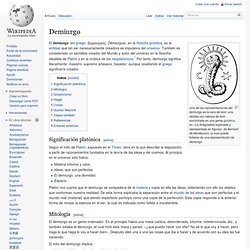
El demiurgo (en griego: Δημιουργός, Dēmiurgos), en la filosofía gnóstica, es la entidad que sin ser necesariamente creadora es impulsora del universo. También es considerado un semidiós creador del Mundo y autor del universo en la filosofía idealista de Platón y en la mística de los neoplatónicos.[1] Por tanto, demiurgo significa literalmente: maestro, supremo artesano, hacedor; aunque resaltando el griego significaría creador.
Carlingo. The Enochian Alphabet - Language of the Angels - Vincent Bridges & Dan Winter part 2 of 8. The Hermetic Hour - Enochian Magick 3. Hipóstasis de los Arcontes. La Hipóstasis de los Arcontes es un texto que se ha conservado en un único testigo copto, constituyendo el tratado 4 del Códice II de Nag Hammadi (NHC II, 4, pp. 86, 20 – 97, 23).

Está precedido por el Libro Secreto de Juan y los evangelios de Tomás y Felipe, y seguido por el Escrito sin Título y la Exégesis del Alma. Se encuentra en un muy buen estado de conservación, con algunas lagunas menores. El título aparece explícito. La traducción castellana la Hipóstasis de los arcontes se limita a reproducir los términos griegos del título copto. Una traducción según el significado de esos vocablos griegos sería “la realidad de la potestades”.
Idioma y lugar de origen[editar] La lengua de la versión copta es el sahídico con fuertes contaminaciones subacmímicas, como en todo el Códice II. Proceso de formación[editar] El texto, en su estado actual es el resultado de la reedición cristiana de un texto originalmente judío. Hipóstasis de los Arcontes. Indigo Children Radio Online Radio by IndigoChildrenRadio. Corpus Hermeticum - John Everard. The Alchemy web site on Levity.com The Divine Pymander in XVII books..

London 1650. This was translated by John Everard from the Ficino Latin translation. Neoplatonism. Neoplatonism and Gnosticism. Mithraic mysteries. Double-faced Mithraic relief.
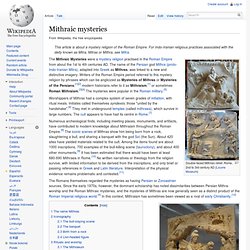
Rome, 2nd to 3rd century AD (Louvre Museum) The Mithraic Mysteries were a mystery religion practised in the Roman Empire from about the 1st to 4th centuries AD. The name of the Persian god Mithra (proto-Indo-Iranian Mitra), adapted into Greek as Mithras, was linked to a new and distinctive imagery. Theurgy. Definitions[edit] Neoplatonism[edit] Although the Neoplatonists are considered polytheists, they embraced a form of monism.

Iamblichus' analysis was that the transcendent cannot be grasped with mental contemplation because the transcendent is supra-rational. Esoteric Christianity. Esoteric Christianity is an ensemble of spiritual currents which regard Christianity as a mystery religion,[1][2] and profess the existence and possession of certain esoteric doctrines or practices,[3][4] of which the public is unaware (or even to which they may be denied access) but which are understood by a small group of people.[5] These spiritual currents share some common denominators, such as: Mystery religion[edit] Early Christians used the Greek word μυστήριον (mysterion) to describe the Christian Mystery.
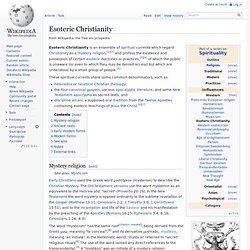
The Old Testament versions use the word mysterion as an equivalent to the Hebrew sôd, "secret" (Proverbs 20:19). Rosicrucianism. Rosicrucianism is a generic term referring to studies or membership within a philosophical secret society said to have been founded in late medieval Germany by Christian Rosenkreuz.
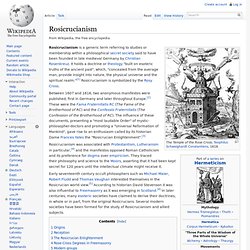
It holds a doctrine or theology "built on esoteric truths of the ancient past", which, "concealed from the average man, provide insight into nature, the physical universe and the spiritual realm. "[1] Rosicrucianism is symbolized by the Rosy Cross. Henosis. Archon. Depiction from the east frieze of the Parthenon, of an assumed Archon Basileus, a remnant title of the Greek monarchy Archon (Gr. ἄρχων, pl. ἄρχοντες) is a Greek word that means "ruler" or "lord," frequently used as the title of a specific public office.
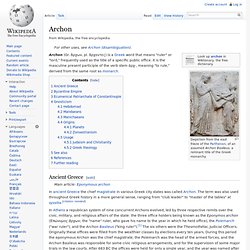
Sethianism. The Sethians were a Gnostic sect during the Roman era.

Alongside Valentinianism Sethianism was one of the main currents of Gnosticism during the 2nd to 3rd centuries. Their thinking, though it is predominantly Judaic in foundation, is arguably strongly influenced by Platonism. Sethianism attributed its gnosis to Seth, third son of Adam and Eve and Norea, wife of Noah (who also plays a role in Mandeanism and Manicheanism).
Mentions of the Sethians[edit] Demiurge. Sabians. The Sabians and the Wisdom of the Stars - Humanity Healing Network. “And the angel of the LORD called unto Abraham out of heaven. ~Genesis 22:15 “…in thy seed shall all the nations of the earth be blessed; because thou hast obeyed my voice.” ~Genesis 22:18 “And I will make thy seed to multiply as the stars of heaven, and will give unto thy seed all these countries; and in thy seed shall all the nations of the earth be blessed;…” ~Genesis 26:4. Mandaeism. "Mandaean" redirects here. For the ethnoreligious group, see Mandaeans. "Mandean" redirects here. For the language family in West Africa, see Mande languages. According to most scholars, Mandaeans migrated from the Southern Levant to Mesopotamia in the first centuries CE, and are of pre-Arab and pre-Islamic origin. They are Semites and speak a dialect of Eastern Aramaic known as Mandaic.
Hermetica. Scope[edit] The term particularly applies to the Corpus Hermeticum, Marsilio Ficino's Latin translation in fourteen tracts, of which eight early printed editions appeared before 1500 and a further twenty-two by 1641.[2] This collection, which includes the Pœmandres and some addresses of Hermes to disciples Tat, Ammon and Asclepius, was said to have originated in the school of Ammonius Saccas and to have passed through the keeping of Michael Psellus: it is preserved in fourteenth century manuscripts.[3] The last three tracts in modern editions were translated independently from another manuscript by Ficino's contemporary Lodovico Lazzarelli (1447–1500) and first printed in 1507.
Extensive quotes of similar material are found in classical authors such as Joannes Stobaeus. Gospel of Truth. The Gospel of Truth is one of the Gnostic texts from the New Testament apocrypha found in the Nag Hammadi codices ("NHC"). It exists in two Coptic translations, a Subakhmimic rendition surviving almost in full in the first codex (the "Jung Codex") and a Sahidic in fragments in the twelfth. History[edit] But the followers of Valentinus, putting away all fear, bring forward their own compositions and boast that they have more Gospels than really exist.
The Soul Travelers. S Boschetto - The Watchers. Common to almost all Pagan/Witch/Wiccan traditions is the concept of the Watchers or the Keepers or the Guardians. They are known by many names in many traditions. In the teaching of various cultures, these entities are called by many names including: Agents, Angels, Conscious Thought Forms, Creative Energies, Devas, Fathers, Fountains, Gates, Governors, Hands of God, Lords, and Shining Ones.
Grimoires (Download) Max Krav Maga : Online Krav Maga Lessons and Training Videos.
Pearltrees videos. Pearltrees tips. Resurecting the Dead.